The majority of pure, wild-strain Endler’s livebearers available in the hobby today originally came from Laguna de Los Patos in Cumana, a small region in northern Venezuela. (1)
These colorful little livebearers were originally discovered in 1937 by Franklyn F. Bond and later re-discovered by Dr. John A. Endler in 1975.
Armando Pou and Adrian Hernandez (aka AdrianHD) have done much work in collecting and line-breeding wild stock to make this species available to the hobby.
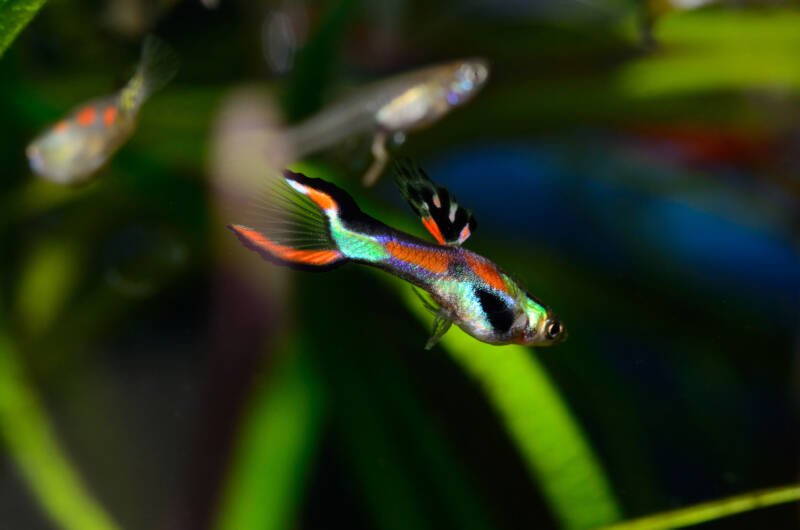
Today, many of the fish marked as “endlers” that are available from shops and hobbyists are hybrids.
Endler’s livebearers (Poecilia wingei) can produce viable offspring with guppies (Poecilia reticulata), and these hybrids are much more common than documented wild strains.
Their care is essentially the same, though, and they’re nonetheless a wonderfully colorful and striking addition to any home aquaria!
At a Glance
| Minimum tank size: | 10 gal (40 l) |
| Group size: | 6+ (1 male : 2 females ratio) |
| Lifespan: | 2-3 years |
| Size: | males .75-1” (1.9-2.5 cm); females 1.25-1.75” (3.0-4.4 cm) |
| Temperature: | 76-84°F (24-29°C) |
| pH: | 6.5-8.0 |
| Water parameters: | 0 ppm ammonia, 0 ppm nitrite, < 20 ppm nitrate |
In this article
What’s in a Name?
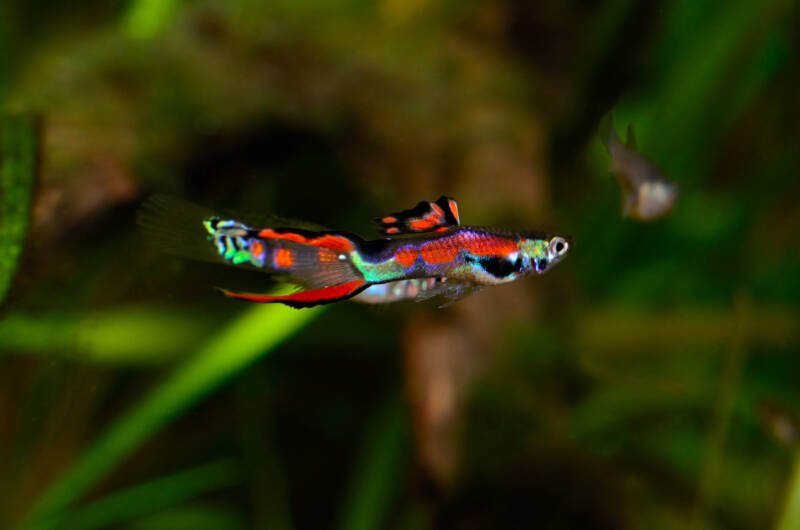
This fish has quite a few common names: Endler’s livebearer, Endler’s guppy, Cumana guppy, or simply endler.
They were originally referred to as Cumana guppies, after their region of origin.
The stock collected by Dr. Endler in the mid-70s passed through a few hands and was referred to as Endler’s guppy or livebearer until it was given its own classification in the early 2000s: Poecilia wingei.
Poecilia comes from the Greek “poikilo” which means “variable” or “variegated”.
These fish show an insane amount of color and pattern variation, as do their guppy relatives! The species name wingei honors Dr. Ojvind Winge, who published research pertaining to guppy genetics and breeding.
By the time they had been scientifically classified, their “endler” nickname had stuck and it’s how most of the hobby still refers to them today.
Identification
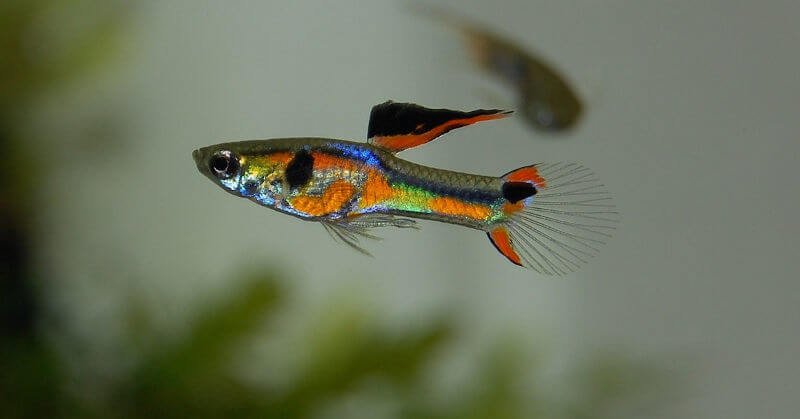
Endlers have a very distinctive color-blocked pattern. They’re often seen with splotches of red, orange, green, black, yellow, and blue.
One of the most distinctive markings is a black spot or bar on the upper body. Not all strains, wild or hybrid, display this marking but the majority of them do.
For some examples of wild strains and patterns, check out AdrianHD’s SwampRiverAquatics. (It seems that the site has been left up as a reference point and is no longer a viable point of sale or advertisement for AdrianHD).
Endler’s Class Types
Class N
A Class N endler is from a pure, wild strain that has accompanying documentation of some sort tracing it back to its collection point.
This may mean wild-collected fish, or it may mean the offspring of a wild-collected fish which has resulted from a pure pairing.
Orchid endlers are a popular pure strain.
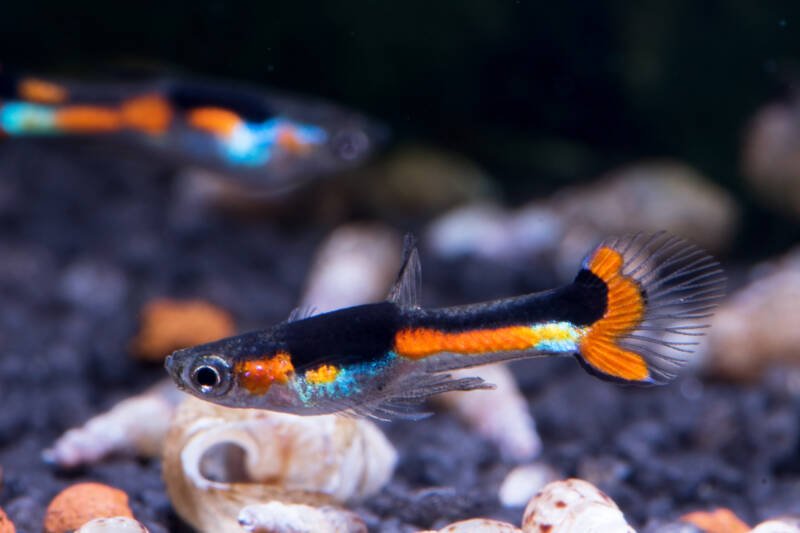
Class K
Class K fish are probably the most widely available.
These are the endlers that are the result of crossbreeding with guppies.
They come in an assortment of colors and tail types, and the variations are part of what makes this class of livebearers attractive to keepers.
Tiger yellow jacket and paradise endlers fall into this class.
Class P
Class P endlers are fish that appear to be a pure stock but don’t have any documentation.
If there is no way to prove (with documentation) that they are in fact pure stock, they should fall into this class.
Behavior
Like other Poecilia species, these fish are social and do best when kept in groups of six or more.
Endlers don’t school tightly, so their behavior falls more in line with shoaling. They tend to spend a lot of time near the top of the tank but are extremely outgoing and active, so they’ll use every gallon you give them.
Males constantly display for and chase the females (which is why it’s important to have at least two females for every male).
This courting behavior is called a sigmoid display. The males will fan out their dorsal fin, curve their body, and wriggle ever so slightly in an attempt to win over a female.
Sexing
Poeceilia wingei is a sexually dimorphic species. This means that there are differences between the size and appearance of males and females.
Males are much smaller (nearly half the size!) and more colorful than females. In the image below, the female is on the bottom. (2)
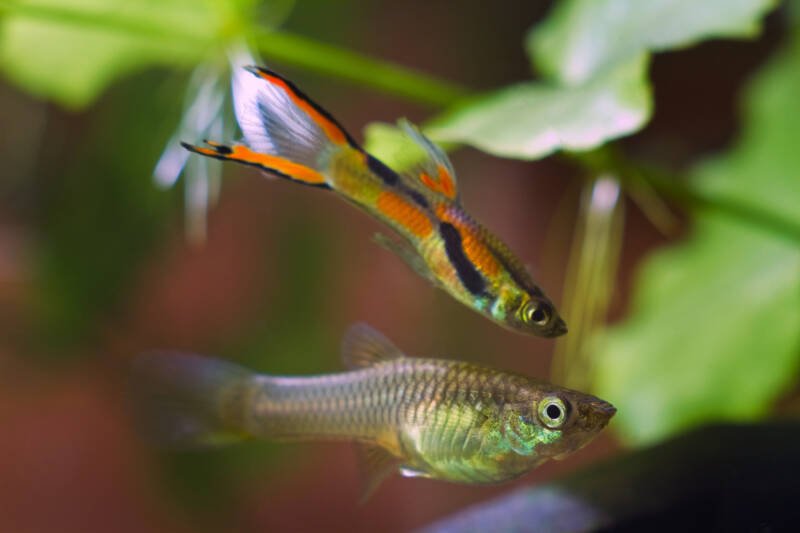
Care
These stunning, hardy livebearers make for wonderful first-time fish for the beginner aquarist. They’re just as stunning and hardy for the experienced aquarist too, though!
If you’re planning to keep these fish for funsies and not specifically for breeding purposes, they’ll do well in just about any kind of tank.
They’re not picky about the type of substrate, décor, plants, lighting, etc. you choose. As long as you’ve got a properly cycled 10+ gallon (40 l) tank they’ll make do.
These fish are also pretty lenient when it comes to temperature. They’ll tolerate temperatures as low as 65°F (18°C) all the way up to 84°F (29°C).
They do best when kept in the mid to high 70s (24-27°C).
Regardless of the type of décor you choose, I’d recommend making sure there’s plenty of it. Males will constantly be courting the females and ensuring there are enough spaces for them to retreat to is important!
If you decide to keep only males (whether for their coloration or to avoid batches of fry), this is equally important, as males can be territorial.
If you decide to keep only females to avoid unwanted fry, be aware that they may be pregnant when you bring them home, or they may become pregnant even if there aren’t any males in your tank.
Guppies, and other Poeciliid fish, can hold sperm for a period of months, meaning you may still end up with large batches of fry. (source)
Avoiding CatastropHe

Something I’ve heard over and over again is that “endlers need hard water”.
And while it is true that they do better in harder water with higher pH than in softer water with lower pH, there is no hard and fast rule that applies to every tank.
There are so many variables at play when it comes to water chemistry and your stock.
What kind of tap water do you have? Where were your fish bred? What kind of water were they kept in at the fish store or wholesaler facility? How do pH and water hardness affect the species you’re keeping?
In general, making sudden changes or causing large fluctuations in water chemistry in the pursuit of ideal parameters does more damage than leaving well enough alone.
I’m not saying that you should never change your water chemistry, though. Rather than nuance is important and understanding different aspects of water chemistry helps you make the best decisions for your tank.
I highly recommend giving this video a watch or listen.
It’s conversational and touches on a lot of topics concerning whether or not keepers should alter the water chemistry in their guppy and livebearer tanks.
Tankmates and Stocking
Endler guppies are very active and won’t hesitate to swim over every single square inch of their tank.
Because of their outgoing nature, they pair well with shyer nano fish (like Celestial pearl danios).
They also do well with guppies as they have similar care requirements. Just know that these fish can produce viable offspring when paired with other livebearers and that they hybridize especially well with guppies.
Bottom-dwelling fish like Corydoras species make fantastic tankmates.
They have similar care requirements and there are smaller nano species which do well in 10-20 gallon tanks (40-80 l) in case yours is on the smaller side.
They keep to the bottom of the tank, meaning they’ll help clean up bits of food the guppies missed, but they also won’t be competing with your endlers for tank space.
They do best in a tank with soft sand. They use their mouths and barbels to sift through substrate looking for food, and gravel or rough substrates may damage their barbels or undersides.
Being peaceful fish, they do well with equally peaceful invertebrates. Shrimp and snails come in just about every size and color, so there’s a little something for everyone.
It’s best to avoid crayfish, turtles, and larger or particularly aggressive fish, like cichlids, which could predate on your endlers.
Tank Setup and Maintenance
Supplies
- 10+ gallon (40 l) aquarium
- Stand
- Light
- Filter
- Heater
- Thermometer (glass or digital, avoid sticker thermometers)
- Substrate
- Décor
- Water change equipment
- Water conditioner
- Water test kit
Aquarium, Stand, Filtration, Lighting, & Temperature
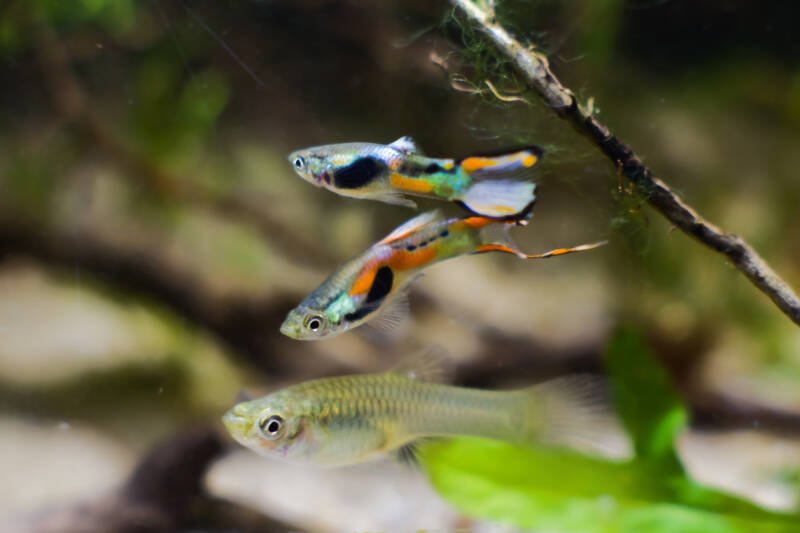
These livebearers aren’t going to need a special tank or stand. If it holds water and sits on a stable surface, it’ll do.
They won’t need a specific type of filtration system, but they’re pretty small fish so as long as you don’t pick the world’s most powerful filter, yours will suffice.
When it comes to the lighting and heating, consider the lighting needs of your plants (if you’ve got plants) and invest in an adjustable heater.
Even with adjustable heaters, though, it’s important to have a thermometer to make sure everything is as it should be!
I highly recommend glass or digital thermometers as the sticker ones can be unreliable.
Substrate
When it comes to substrate, these fish don’t have any special needs or preferences.
However, you should consider the needs of any plants or tankmates when picking out your substrate!
Décor
I’m a sucker for planted tanks, so I’m almost always going to recommend them to y’all.
I just love the way the greenery makes all the colors on the fish pop. Also, live plants use up waste compounds in the water and provide a place for biofilm to grow (which makes for a great snack).
I have absolutely nothing against plastic décor and colored gravel, though, and neither will your fish.
Your tank is what you make of it and at the end of the day, if a planted tank would add more stress to your fishkeeping experience, it’s probably not worth it.
As long as your fish are swimming and eating and you’re keeping up with your water changes, you’re probably doing a pretty bang-up job! Sit back and enjoy your fish!
Water Change & Monitoring Equipment
Speaking of water changes, you’ll need to invest in some water change and monitoring equipment if you don’t already have some.
If this is your first tank, it’s worth the investment. I’m sure you’ll be setting up your 2nd and 3rd tank very soon. This hobby is extremely addictive!
My personal recommendation would be to pick up a standard 5-gallon (20 l) bucket, siphon (they come in different sizes and lengths to accommodate tank size and volume), liquid test kit, and water conditioner.
The kit will help you know when to perform a water change and the other stuff will help you actually do the water change.
Food & Diet
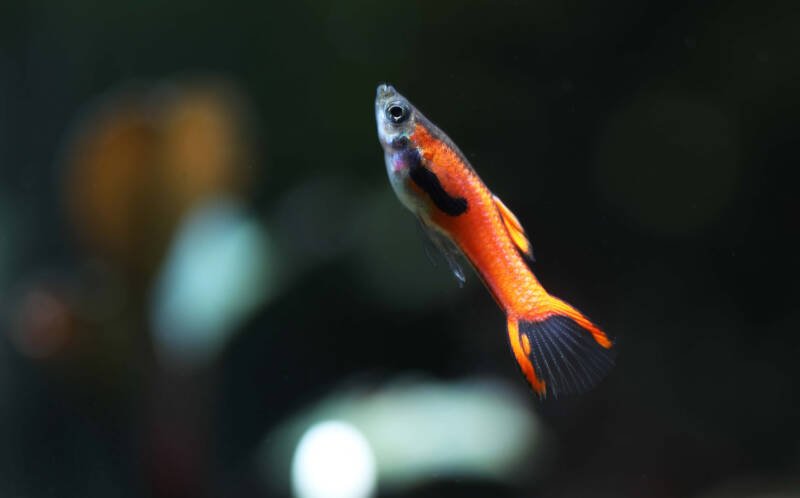
These fish don’t seem to be very picky eaters. From my experience, they’ll probably eat whatever they can fit in their mouths.
Their mouths are pretty small, though, so high quality flakes and micro pellets make for a good, dry staple diet.
They’ll also readily accept frozen and live foods like microworms, blood worms, and brine shrimp.
Fry will pick at bits of leftover food and endlers of any age will enjoy snacking on some biofilm (which often grows on the leaves of plants) or algae.
Breeding
Constant courtship and breeding can be taxing for the females, though, so it’s important to provide plenty of cover and hiding spots for them.
These fish are prolific breeders. They’re livebearers, meaning they birth teeny tiny, fully formed fish.
Females can produce up to 30 babies every three weeks or so (23 days to be precise). Though it seems 10-20 is more of an average brood size.
Temperature can affect the sex of offspring. Higher temperatures will result in more males and lower in more females. (3)
If you plan on keeping males and females together, you’ll need to have a plan for all the extra fish.
Some keepers have large tanks to account for all the future fish, and others take them to local fish stores or rehome them.
Regardless of what you choose to do with your fry, plan ahead so you don’t end up with a severely overstocked tank.
Disease
Ich
Ich is short for Ichthyophthirius multifiliis (say that five times fast!), which are external parasites that look like small grains of salt.
Because these fish can tolerate higher temperatures, cranking your heater up to 84°F (29°C ) and using a medication like Ich X might be a good place to start.
Water changes and aquarium salt are also helpful!
Tail & Fin Rot
These fish can have some gorgeous, large finnage, but they can also be susceptible to fin and tail rot.
Rot is characterized by black-tipped, receding finnage.
Extremely clean water is one of the easiest ways to combat these types of infections, though! So performing water changes more often is a good start.
If it progresses rapidly and the extra water changes aren’t helping, move on to quarantining and medication.
Seachem’s Kanaplex is a good option for treating severe cases of fin and tail rot. It’s handy to have in your supply bin for other illnesses as well.
Happy Fishkeeping!
As always, comments and criticisms are welcome down in the comments below!
Feel free to share your experiences or questions with us and the other keepers that visit.
I hope you enjoy keeping these awesome livebearers as much as I have. Good luck and happy fishkeeping!